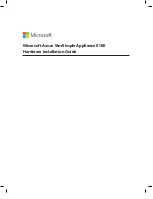
F
EATURES
AND
S
PECIFICATIONS
R
EVISED
2018-09-21
O
VERVIEW
OF
A
DVANCED
F
EATURES
D
RAWING
N
O
. LP0991-G
1-2
N-Tron
®
Series NT24K
®
Software Manual
1.2
Overview
of
Advanced
Features
1.2.1
Mode
of
Operation
Each port on the switch can be configured to support different modes of operation as shown below:
Half
‐
Duplex
In half-duplex mode, the CSMA/CD media access ports share a common transmission medium. To transmit, a port
waits (defers) for a quiet period on the medium (that is, no other port is transmitting) and then sends the intended
message in bit-serial form. If, after initiating a transmission, the message collides with that of another port, then
each transmitting port intentionally transmits for an additional predefined period to ensure propagation of the
collision throughout the system. The port remains silent for a random amount of time (back-off) before attempting
to transmit again.
Full
‐
Duplex
Full-duplex operation allows simultaneous communication between a pair of ports using point-to-point media
(dedicated channel). Full-duplex operation does not require that transmitters defer, nor do they monitor or react to
receive activity, as there is no contention for a shared medium in this mode.
However, a receiving endpoint may request that the transmitting endpoint pause transmission to prevent receive
buffer overflow. When the receiving buffer capacity becomes sufficient again, the receiving endpoint will notify the
transmitting endpoint that transmission may resume.
Auto
‐
Negotiation
In Auto-Negotiation mode, the port/hardware detects the mode of operation of the port that its connected to and
sets its mode to match.
1.2.2
Port
Mirroring
A Mirroring Port is a dedicated port that is configured to forward copies of Ethernet frames that are being sent or
received from a monitored port. This is normally only used during troubleshooting and debug of the network. Under
normal operation, Port Mirroring is disabled.
1.2.3
Port
Trunking
Port Trunking is the ability to group network ports to increase the bandwidth between two machines (e.g., switch or
any work station). This feature allows grouping of high-speed connectivity and provides a redundant connection
between switches, so that a trunk can act as a single link between the switches.
Copper Ports:
1000Base Copper or any Fiber Ports:
•
Half-Duplex
•
Full-Duplex
•
Full-Duplex
•
Auto-Negotiation












































